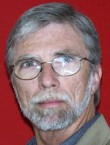Reprinted from the Tideland News.
SWANSBORO — After more than nine years of legal maneuvers and negotiations, the state of North Carolina finally owns all the 290 acres of mainland property it has long sought to add to Hammocks Beach State Park just outside of town.
Supporter Spotlight
Bill Holman, North Carolina director of The Conservation Fund, an organization based in Arlington, Virginia, said on Dec. 29 that the group had just before Christmas sold the state for $1.3 million the last 45.36 acres of Hammocks Beach property formerly owned by John Hurst and Harriet Hurst Turner. The appraised value was about $1.59 million, so Holman called it a good deal for the state.

“We’re delighted that state parks completed acquisition of the last 45-acre tract in the centennial year of the State Park system, and we all look forward to more public access and more public use of Hammocks Beach State Park,” Holman said.
Likewise, Charlie Peek, spokesman for the state parks department, said officials there were grateful.
“Once again, The Conservation Fund has proven to be an invaluable partner of North Carolina State Parks with its assistance in adding this property to Hammocks Beach State Park,” he said. “We look forward in 2017 to completing a master plan for all the additional mainland property that will properly balance protection of its rich natural resources with its recreation potential.”

David Pearson, president of the Friends of the Hammocks and Bear Island, the park’s volunteer support group, said he, too, was glad the sale was complete.
Supporter Spotlight
Pearson, who was instrumental in the long negotiations and the final settlement of the court case over the property, added that he hopes the public will soon be allowed to make use of the land. The state, The Conservation Fund and Hurst and Turner, heirs to a piece of waterfront property once used as a retreat for black teachers and their families, had closed on the deal in April.
The sale required two transactions. In one, the state paid Turner and Hurst $6.9 million for 200 acres of the tract, using a combination of funds from the state’s Parks and Recreation Trust Fund, money appropriated by the legislature, and from the sale of bonds designated for the purpose.
In a second sale, The Conservation Fund paid $3.1 million for the remaining 90 acres, which it immediately leased back to the state. The original terms called for a payback period of no more than three years. The money for this final purchase came from the Parks and Recreation Trust Fund.
The state is in the process of deciding how to use the property. It hired SageDesign, a Wilmington firm, to develop the master plan, which is expected to be complete by this spring.
It remains unclear whether a proposed boat launch will be built on the new property.
The controversial boat ramp proposal, which Pearson said had been around in one form or another for years, came fully to the attention of area residents around the time that voters approved a $2 billion state bond referendum in March. The bond included $75 million for state parks, of which $1.125 million went to Hammocks Beach.
Proponents said the ramp is much needed in the area and would fit well in the park, which now has four islands, including Bear Island, site of the popular and recreational ocean beach that is accessible only by state ferries and private boats.
But many in the area didn’t know that money was earmarked for a boat ramp, which wasn’t listed in the legislation that authorized the referendum. Those opposed to the idea said the ramp would ruin the tranquility of the park, increase traffic on Hammocks Beach Road and, if built on the 290 acres the park acquired on Queens Creek, damage the fragile ecology of the stream.

Members of the park’s volunteer, nonprofit Friends group, met on Oct. 27 and voted 23-7 to oppose construction of a boat launch in Hammocks Beach State Park.
SageDesign had already held a public meeting to get input on the plan, on Sept. 29. Attendees indicated their preferences for potential uses they’d like to see on the land, ranging from hiking and biking trails to educational facilities, from volleyball and bocce courts to boat ramps.
Hiking and biking trails were the choice of the most people that night, along with fishing. The boat ramp had its fans, too, but not in such great numbers.
Sara Burroughs of Sage Design said in December that the plan-development process was on schedule to be complete by spring.
“We’ve received a lot of input, and we’re putting that into charts so we can see those commonalities and differences,” Burroughs said.
Some of that input came from the North Carolina Coastal Federation, which in November sent Sage Design a letter in which executive director Todd Miller and Sam Bland, a former superintendent of the park and now a coastal specialist for the federation, urged that great care be taken not to change the natural state of the land. The area includes important forest habitat for plants and wildlife and functions as an important watershed for the area, according to the letter.
State officials have said the fate of the boat ramp idea hangs on public input, and Sage plans another public meeting in February.
Terms of the land sale, which took place in April 2015, included a provision that Harriet Turner be allowed to develop a camp on the site for underprivileged children. Pearson said he hopes that still happens, as it has long been the desire of the Hurst heirs, but there has been no movement on that front.
This story is provided courtesy of the Tideland News, a weekly newspaper in Swansboro. Coastal Review Online is partnering with the Tideland to provide readers with more environmental and lifestyle stories of interest about our coast. You can read other stories about the Swansboro area here.







